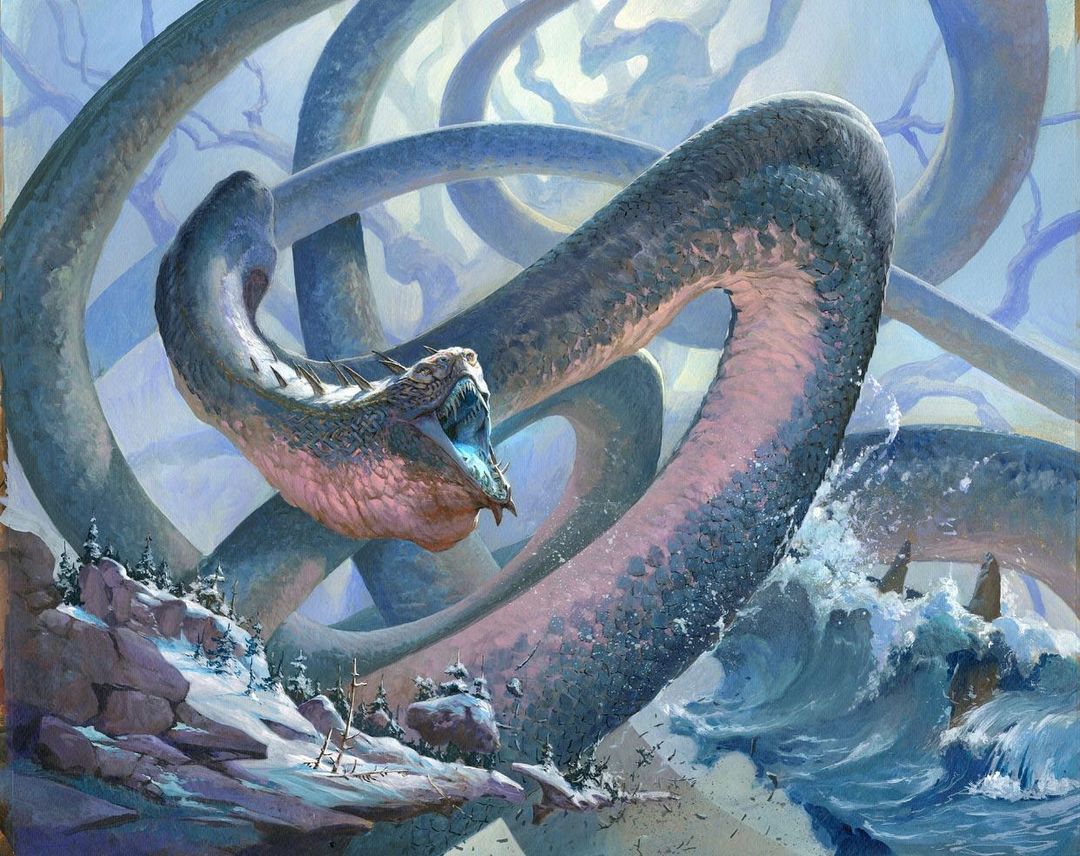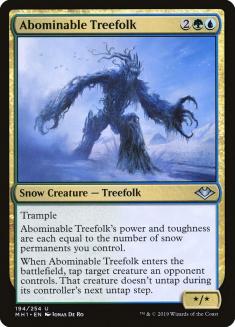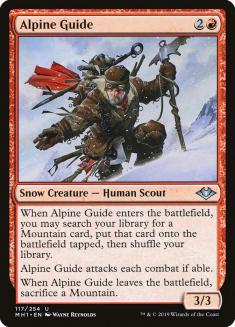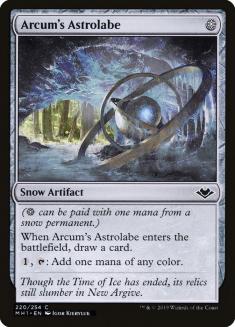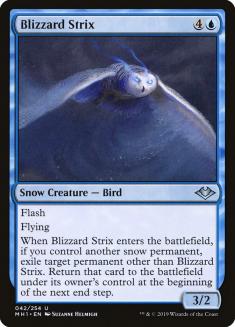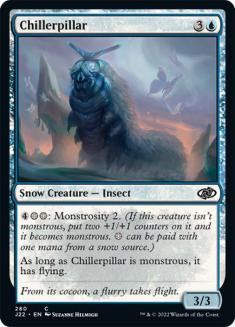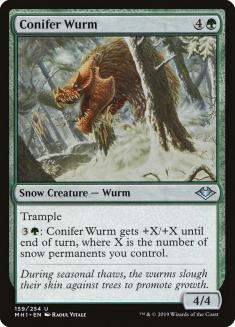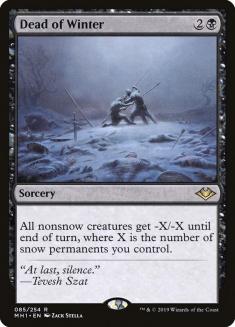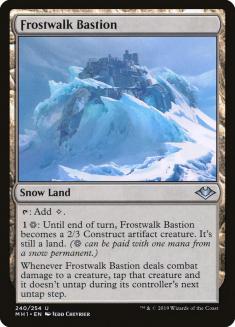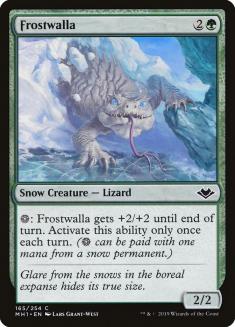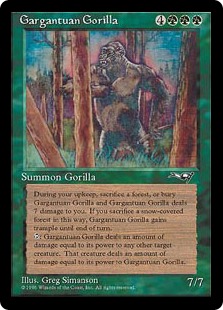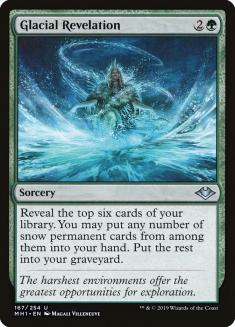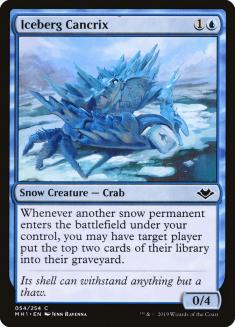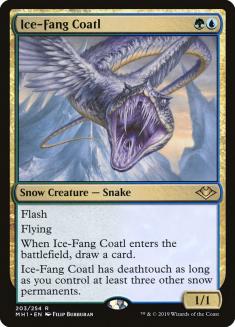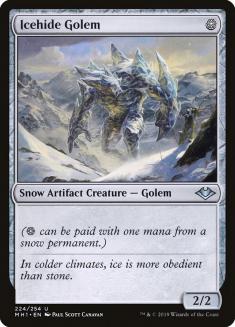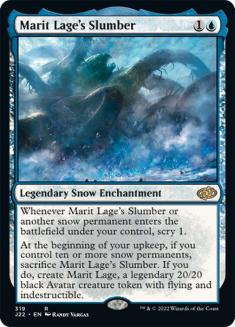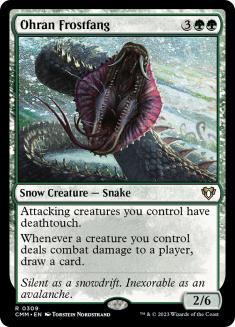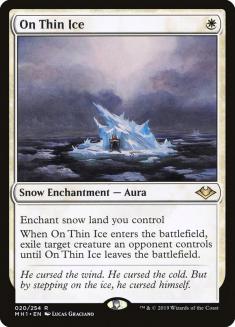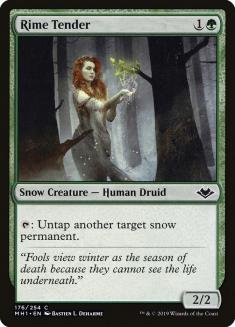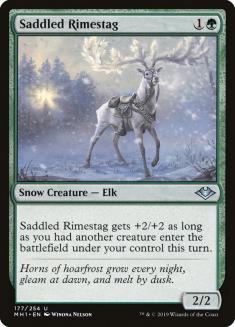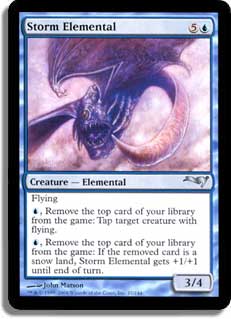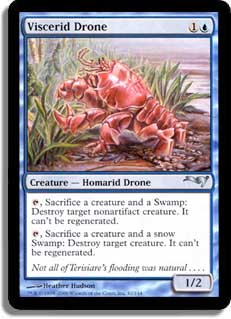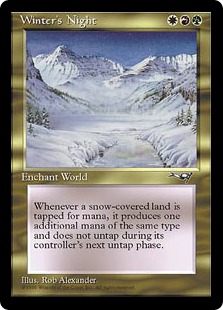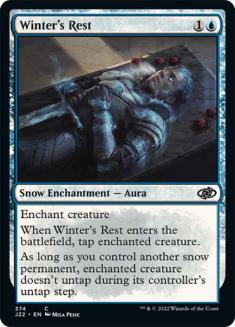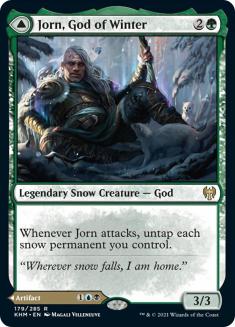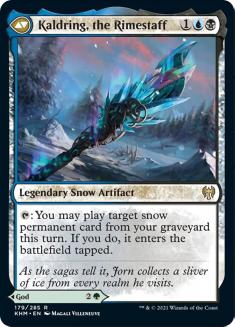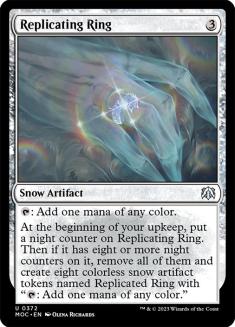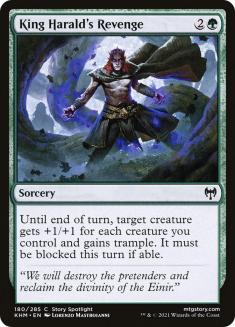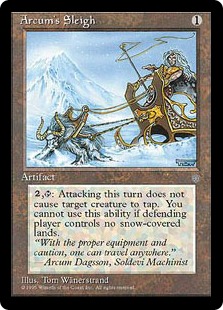As I’ve hinted at previously, the Commander Rules Committee is ready to debut a new Commander variant called Snow Battles. This one comes from the fertile mind of fellow Commander RC member Scott Larabee and was further developed by the rest of the team. It’s pretty straightforward.
Snow Battles is Commander with decks constructed using the following sets: Kaldheim, Coldsnap, and Ice Age. Kaldheim includes the sixteen Kaldheim Commander cards in their first printing (like Cosmic Intervention or Pact of the Serpent). In addition, the following cards, which reference snow or non-snow (most of them from Modern Horizons), are also legal:
For now, there’s a single banned card, Amulet of Quoz, since it’s an ante card. We started going down a road where we thought to include cards that had snow-adjacent names, like Frost Titan or Thing in the Ice, but that would mean a relatively large list of additional allowable cards, with some awkward messaging. Like in many things we do, we decided to keep it relatively simple in order to be able to clearly articulate what the variant is about.
The remainder of the rules follow along with normal Commander as far as deck construction and color identity.
Going into putting Snow Battles together, we made two agreements. First, we’d all decide beforehand which commanders we’d play so that we didn’t have duplicates. We wanted to make sure there was sufficient variety in play, especially for streaming.
Then, after examining the card as well seeing my Jorn Snow Rogues deck in action a few times, we decided that none of us would play Jorn, God of Winter. It seems like it’s just objectively the best choice—playing on easy mode in the Snow Battles variant. It’s one of the few three-color choices available, which is already a significant advantage, especially since it has green and access to what ramp is available. Add to that its self-mana acceleration ability from the commander, and it seems like even a deck not constructed to go full ham too early would easily dominate the table. We’d like more creative, interactive games.
When it came down to picking commanders, I waited to see what the other three wanted to play. Toby picked from what he opened in his one box, ending on Sarulf, Realm Eater. Early on, Scott considered Zur, the Enchanter or Merieke Ri Berit, then switched up to Esika, God of the Tree after also thinking about Ranar, the Ever-Watchful. He finally settled on Esika, planning on playing it as a Bant deck with just a splash of black. Gavin settled on Firja, Judge of Valor which is also his Boxing League commander; he simply upgraded it with some additions. He also got Crippling Fear and Doomskar in his pool, so it looks like in both Boxing League and Snow Battles, he’ll be the control deck.
That left me with some still-saucy choices. I briefly also looked at Merieke; I like her ability, but it seemed like the support was a little sketchy. Elves was kind of an obvious choice for the best remaining deck—the cards are there and it’s pretty savage. That made me actually lean away from it. It seems like Elves would determine the pace of play of every game, effectively making games into an Archenemy contest. Seems like less fun to me.
In the end, I also went for my Boxing League commander, Koma, Cosmos Serpent. It’s a single-card strategy that might take a while to get going, but once it does, it can be quite strong. Here’s the list:
Creatures (36)
- 1 Fyndhorn Elves
- 1 Brown Ouphe
- 1 Fyndhorn Elder
- 1 Allosaurus Rider
- 1 Boreal Centaur
- 1 Boreal Druid
- 1 Ohran Viper
- 1 Rimefeather Owl
- 1 Rimewind Cryomancer
- 1 Centaur Omenreader
- 1 Ice-Fang Coatl
- 1 Abominable Treefolk
- 1 Chillerpillar
- 1 Rime Tender
- 1 Conifer Wurm
- 1 Blizzard Strix
- 1 Ohran Frostfang
- 1 Realmwalker
- 1 Gladewalker Ritualist
- 1 Toski, Bearer of Secrets
- 1 Sarulf's Packmate
- 1 Inga Rune-Eyes
- 1 Alrund, God of the Cosmos
- 1 Sculptor of Winter
- 1 Battle Mammoth
- 1 Spirit of the Aldergard
- 1 Boreal Outrider
- 1 Bloodline Pretender
- 1 Jaspera Sentinel
- 1 Ascendant Spirit
- 1 Frostpeak Yeti
- 1 Cosima, God of the Voyage
- 1 Frost Augur
- 1 Horizon Seeker
- 1 Ravenous Lindwurm
- 1 Icebreaker Kraken
Lands (37)
Spells (26)
- 1 Brainstorm
- 1 Nature's Lore
- 1 Soul Barrier
- 1 Binding Grasp
- 1 Ray of Command
- 1 Counterbalance
- 1 Into the North
- 1 Mystic Melting
- 1 Perilous Research
- 1 Disdainful Stroke
- 1 Marit Lage's Slumber
- 1 Broken Wings
- 1 Absorb Identity
- 1 Behold the Multiverse
- 1 Blessing of Frost
- 1 Replicating Ring
- 1 Maskwood Nexus
- 1 Run Ashore
- 1 Moritte of the Frost
- 1 Blizzard Brawl
- 1 King Harald's Revenge
- 1 The Bears of Littjara
- 1 Mystic Reflection
- 1 Graven Lore
- 1 Depart the Realm
- 1 Spectral Deluge

Putting this deck together was way tougher than I thought it’d be. I knew going in we were dealing with a restricted environment, but I only had an inkling of how deep I’d have to go for good cards. Ice Age, as many of you are aware, is pretty rough. The creatures are overpriced, and some of the best cards are color hate. I knew that a majority of the cards would come from Kaldheim, but I thought I’d find a few Ice Age gems. They were few and far between.
There’s a significant snow component to the deck. A number of decent creatures, headed up by Abominable Treefolk, started me down the path, which was eventually capped by Scrying Sheets. It’s a no-brainer even if some snow hate cards like Reidane, God of the Worthy exist. There’s well enough upside to not be concerned with a card or two that might make things awkward.
With the best ramp available and some good midrange creatures, the plan is to curve into some early threats capped by Koma. After that, the idea is to ride our new favorite Serpent all the way home. Maskwood Nexus will turn everything into Serpents, both providing additional fuel for Koma and protecting my team from Crippling Fear.
An early Icebreaker Kraken could also tip the scales in my direction. It won’t take much to cast it as early as Turn 5 or Turn 6, and then it’s a pretty big beatstick. Speaking of big, Marit Lage’s Slumber is another alternate win condition that might be online comparatively early. The format isn’t going to be all that fast, so there will be ample time for things to unfold. It’s certainly not a primary plan, but it’s a nice backup.
Getting things early will happen courtesy of the ramp/mana acceleration cards. Into the North is the obvious land ramp. Fyndhorn Elves and Fyndhorn Elder do some work, as does Boreal Druid. Jaspera Sentinel is a little slower but still nets a mana with another creature. Sculptor of Winter untaps a snow land and Rime Tender untaps a snow permanent, which is going to be a land early in the game, and then might be reserved for combat tricks later on.
The environment is likely slow enough that an early-turn Replicating Ring might be around long enough to make the eight copies of itself. Artifact removal is at a premium, so it’s highly unlikely anyone is going to waste a precious spell on it.
If I want to go wide, I can get there with Serpents, but there are no good Overrun effects in the card pool. Stampede is hardly worth it, even if it’s an instant. The card that I’m looking at to take advantage of all those Serpent is King Harald’s Revenge, which can easily lead to a commander damage kill with Koma. It won’t take that many trips around the table, piling up the tokens, to make it lethal.
Conifer Wurm might also be able to get pretty large, although without evasion it’ll have to rely on getting blockers out of the way with Spectral Deluge, Blizzard Brawl, or Run Ashore. Absorb Identity is creature bounce that can do other work. Having all my Shapeshifters copy something could be a big blowout. Blizzard Strix will also do the trick, but I suspect that I’m going to want to save that to protect one of my own creatures.
Alrund, God of the Cosmos can get potentially beefy, but it’s there more for the card draw. With 37 creatures in the deck, I know what card type I’m choosing (unless, I suppose, I’m really desperate for lands).
One of the few non-snow creatures is Battle Mammoth. A 6/5 trampler for five is already good enough in the environment. Tack on the card draw ability and you have a fine addition to the somewhat beefy army. Speaking of card draw, there’s also Toski, Bearer of Secrets. When combined with a bunch of battling Serpents, I should be able to keep my hand relatively full.
There are two Ice Age cards that will borrow creatures from opponents, Binding Grasp and Ray of Command. The latter can be either an offensive weapon or a combat trick. I suspect I won’t want to keep a creature long with Binding Grasp. The idea will be to snag something huge that will have to be dealt with, effectively giving me a two-for-one on an opponent.
Another Ice Age card I hope to get some mileage out of it Soul Barrier. It’ll either make creatures two mana more expensive to cast or Shock the opponent. It’s card that I think will be irritating for my opponents but not quite good enough to use their limited enchantment removal on.
For comparison, here’s the Boxing League deck. You can see that I really had to plumb the depths to get the last dozen or so cards. To be fair, my box wasn’t all that great and the only other deck that might be playable is Rakdos Kardur, the Doomscourge. As you’ll no doubt note, the Boxing League deck is more of a one-trick pony than the Snow Battles version. It really leans on Koma.
Creatures (32)
- 1 Toski, Bearer of Secrets
- 1 Sarulf's Packmate
- 1 Masked Vandal
- 1 Inga Rune-Eyes
- 1 Augury Raven
- 1 Kolvori, God of Kinship
- 1 Sculptor of Winter
- 1 Spirit of the Aldergard
- 1 Undersea Invader
- 1 Boreal Outrider
- 1 Guardian Gladewalker
- 1 Littjara Kinseekers
- 1 Pilfering Hawk
- 1 Elderleaf Mentor
- 1 Jaspera Sentinel
- 1 Ascendant Spirit
- 1 Cyclone Summoner
- 1 Berg Strider
- 1 Gnottvold Recluse
- 1 Frostpeak Yeti
- 1 Karfell Harbinger
- 1 Cosima, God of the Voyage
- 1 Draugr Thought-Thief
- 1 Icehide Troll
- 1 Littjara Glade-Warden
- 1 Frost Augur
- 1 Horizon Seeker
- 1 Brinebarrow Intruder
- 1 Orvar, the All-Form
- 1 Grizzled Outrider
- 1 Ravenous Lindwurm
- 1 Mistwalker
Lands (37)
Spells (29)
- 1 Annul
- 1 Strategic Planning
- 1 Disdainful Stroke
- 1 Broken Wings
- 1 Absorb Identity
- 1 Behold the Multiverse
- 1 Ravenform
- 1 Snakeskin Veil
- 1 Replicating Ring
- 1 Esika's Chariot
- 1 Saw It Coming
- 1 Maskwood Nexus
- 1 Run Ashore
- 1 Moritte of the Frost
- 1 Blizzard Brawl
- 1 Glittering Frost
- 1 Roots of Wisdom
- 1 Mammoth Growth
- 1 Rune of Flight
- 1 King Harald's Revenge
- 1 Funeral Longboat
- 1 Raiders' Karve
- 1 The Bears of Littjara
- 1 Arachnoform
- 1 Struggle for Skemfar
- 1 Rune of Might
- 1 Icebind Pillar
- 1 Bind the Monster
- 1 Depart the Realm

It wasn’t my plan going in, but I can see why Gavin wants to just adapt his Boxing League deck for Snow Battles. Kaldheim is still going to provide the predominance of the cards that go in, and then you’ll cherry-pick from the best of the Ice Age and Coldsnap.
The delve into Ice Age cards did uncover an interesting question on a card you (justifiably) never see played: Arcum’s Sleigh. As I was looking at it, I pinged the joint RC/CAG Discord server channel with the question, “Does this card even work?”
My thought process was that you don’t get priority in combat to activate Arcum’s Sleigh until after you have already declared attackers and tapped them (rule 508.1f), since you don’t know who the defending player is until that point. That’s when we looked into rule 802, the “attack multiple players” option. In 802.2, things seem clearer:
If we take this at face value, then you can activate Arcum’s Sleigh at beginning of combat before you declare attackers, since everyone is a defending player. But not so fast. Rule 802.2a muddies the waters:
This seems to imply that you still need to know which specific player you’re attacking in order to reference, the defending player, which you can’t do at beginning of combat, since you haven’t yet declared attackers.
Needless to say, this whole thing caused quite a discussion and we eventually got Magic Rules Manager Jess Dunks involved. To make a long story short, Jess and team, which might even include RC representation, are hashing this out. The chat even brought up implications for a few other cards: Kjeldoran Guard, Yare, and Kusari-Gama. The result is TBD for now—it’s a pretty low-priority task, since it involves a card no one has likely played for decades. I’ll let you know when I hear something.
Snow Battles is a Commander format variant that does what you want in one: it provides you a thought-provoking change of pace from your normal games, but it won’t consume you forever. There will be another variant along in a bit, and we can jump onto that one. More and more, we on the RC are finding that the “formatting” of Commander is space we want to explore as often as possible.
Visit my Decklist Database to see my Signature Decks, the Chromatic Project, and more!

